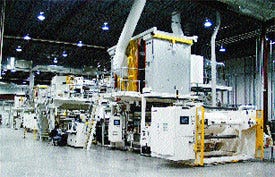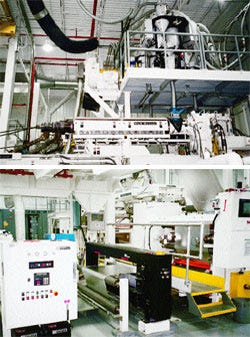High-barrier packaging for healthcare
|
New line is essentially two individual lines in a series, offering the flexibility to run as two independent lines or as a single, tandem line. |
Barrier packaging for healthcare applications has some of the most demanding functional requirements in the flexible packaging industry. Many pharmaceutical, medical device and personal care products require high-barrier protection, particularly products that are sensitive to oxygen and moisture. This packaging must also provide superior sealability and ease of opening. A new tandem extrusion production line at Rexam Healthcare Flexibles, Madison, WI, produces coextruded, laminated materials that meet the requirements of this growing segment. An example of a high-barrier material is paper/polyethylene/ foil/Surlyn® (from DuPont) rollstock for packaging nitroglycerin transdermal patches manufactured by Hercon Laboratories, Emigsville, PA, which was being produced during a recent PD visit.
The packaging for the Hercon nitroglycerin transdermal patches requires a foil-based structure for its high oxygen and moisture barriers, in order to maintain dosage efficacy. The outer paper layer not only provides an excellent print surface, but it also makes the package easier to tear open by elderly users. The Surlyn inner layer was selected because it offers excellent resistance to nitroglycerin as well as superior sealing qualities. As a pharmaceutical company, Hercon must validate the entire manufacturing process for its transdermal patch, establishing high and low running limits for temperature, pressure and dwell time on the packaging equipment. "From a quality standpoint, we absolutely need to have a consistent packaging material from shipment to shipment to be able to run within our validated parameters," comments Don Kauffman, president of Hercon Laboratories.
Dedicated to healthcare packaging, Rexam Healthcare Flexibles has an in-depth understanding of the barrier and opening requirements unique to the healthcare industry, in addition to the rigorous requirements for consistent quality and process control. "We were experiencing a growing demand for high-barrier packaging in healthcare applications; at the same time, we were faced with capacity constraints and aging technology," comments Bob Liesenfelt, product director for laminations. The decision was made to invest in new extrusion technology that would allow Rexam to provide cost- effective packaging solutions for healthcare applications requiring high barriers, such as diagnostic devices, specialty wound dressings, alcohol and iodine swabs, transdermal patches, dry-powder inhalers, and condoms, to name a few.
Rexam Healthcare Flexibles began looking for a new extrusion laminating line in 2000. After identifying companies that could supply the equipment, it assembled a team to come up with a list of parameters to consider in evaluating alternative suppliers. The list included items like process-control capabilities, cost, delivery, systems integration, customer feedback, and others, and each item was assigned a weight. The team evaluated each parameter for each supplier being considered for this project. "Black Clawson was selected for its elegant and intuitive system, its proficiency in systems integration, and its customer satisfaction," says Robert Tweed, Rexam's operations manager in Madison.
Rexam completed the installation of the tandem extrusion-coating/laminating line from Black Clawson in late 2001. "The sheer size of the line was a little daunting. It took twenty-five semi-trailers to deliver all of the equipment," says Tweed, "but Black Clawson was a great help. It took five weeks to install and start up each line, and BC was here the entire time." The total investment of $10 million included a 32,000-sq-ft white-room expansion of the facility to house the new line, featuring a positive, pressure-controlled environment.
The tandem line is essentially two individual lines in a series, offering the flexibility to run as two independent extrusion-coating/laminating lines, or as a tandem line. The lines can run webs up to 66 in. wide at speeds of 1,500 ft/min. The extrusion lines are identical, except that the first line incorporates a single extruder, while the second line has coextrusion capabilities.
Control, blending of resins provides consistency
Most healthcare applications require that packaging materials fall within specified manufacturing control limits. "This is written in stone, comments Kauffman. "The Rexam paper/PE/foil/Surlyn material has consistently been in-spec from shipment to shipment."
|
Resin pellets are delivered to the extruder from overhead metering hoppers, top. System uses beta absorption to measure film thickness, bottom. |
Product consistency is assured through the closed-loop gauge control. The Pro.Net™ Series film-thickness gauging system from NDC Infrared Engineering utilizes state-of-the-art beta transmission sensors that travel back and forth over the web 12 times/min to measure web thickness. The measurement technique is based upon the absorption of beta particles (high-energy electrons) as they interact with the web. Each of the two lines has two of these gauging systems–installed before and after the extruders. The units measure the thickness of the web at these two points, and by subtracting the thickness of the web ahead of the extruder from the thickness after the extruder, the software calculates the thickness of extrudate applied across the web.
The computerized, automatic profile control on the extrusion die, which was supplied by Cloeren, Inc., continuously monitors thickness and can be set to automatically adjust the die lip for optimum cross-machine gauge uniformity. Incorporating this data, Cloeren's AutoGauge™ automatic lip-adjustment system controls the thickness of the web extrudate. Adjustments are made by changing the temperature of heated bolts located across the width of the die by changing the flow of electricity to the bolts. The temperature change causes the bolts to expand or contract and thus increase or decrease the lip opening. The machine parameters can be adjusted automatically or manually to meet the process specs set into the operating system.
Resin pellets are delivered to the extruder from an overhead X Series continuous gravimetric blender from Process Control Corp. Pellets of each type of resin needed for the extrudate being applied are vacuum-conveyed from floor bins into separate weigh hoppers, which in turn feed the extruder. The recipe for the product being run is downloaded from the line's master control unit into the blending-system control unit, which dispenses the proper proportion of each resin from the weigh hoppers. The system measures resin consumption precisely by weight and uses this information to ensure product consistency.
Flexibility and quick changeover reduce lead times
Rexam's tandem line is uniquely configured to run separately as two single lines or together in tandem, says Liesenfelt. "This gives us flexibility to efficiently meet our customers' order size requirements." The new technology allows for changeovers "on the fly." The machine operating parameters can be changed in a matter of seconds from a single point of input, and the auto deckle die allows for changing widths quickly. The chill roll, which determines the surface characteristics of the extrudate, can be changed within 20 minutes. Both lines are equipped with in-line slitting, eliminating a secondary process and contributing to shorter lead times.
One of the new lines is designed to extrusion-coat a substrate, or extrusion-laminate two substrates together by applying multilayer polymer. "This coextrusion-coating capability has enabled Rexam to use emerging resin technologies (such as cyclic olefin copolymers [COCs]) to enhance barrier properties," says Liesenfelt, "and also apply our patented Core-Peel™ seal/peel technology to a broad range of substrates [also see article in this issue, starting on p. 80]." The coextrusion coater/laminator station allows coextrusion in up to five layers in one pass. This would have previously taken multiple passes.
Both lines have individual modules for corona treating, water-based priming, state-of-the art web-guide systems, and flying splices.

"The line has more than lived up to our expectations," says Tweed "It's very intuitive to operate. We have been able to significantly reduce lead times and expand our product offering of high-barrier materials. We are adding another shift of operation to meet the growing demand, and I don't anticipate any problems."
With Hercon's product line growing more than 20 percent per annum, Rexam's investment in the new tandem coextrusion line assures Hercon that the line will be able to keep up with its high-barrier packaging needs far into the future.
More information is available:
Barrier packaging materials: Rexam Healthcare Flexibles, 847/362-9000. Circle No. 210.
Surlyn™: DuPont Co., 800/438-7225. Circle No. 211.
Coating/extruding line: Black Clawson, 315/598-71721.Circle No. 212.
Thickness gauge, controls: NDC Infrared Eng., Inc., 626/960-3300. Circle No. 213
Extruder dies: Cloeren, Inc., 409/886-5820. Circle No. 214.
Resin conveying & blending system: Process Control Corp., 770/449-8810. Circle No. 215.
About the Author(s)
You May Also Like




